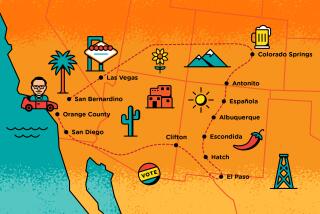<i> A look at noteworthy addresses in the Southland.</i>
On Latino Role Models
âWhen I received the (invitation to speak) it was kind of refreshing that somebody was taking interest in the Westside, because the focus has always been on the Eastside. . . .
âI was actually raised on the Westside, between Santa Monica, West Los Angeles and Mar Vista. So for me growing up as a kid there werenât really role models.
âWhen youâre sitting in a classroom like this and youâre not looking at somebody that reflects you and your history and your culture, itâs very difficult for you or your peers to really feel like thereâs some hope and a chance for you to be in the driverâs seat.
âGrowing up here, I didnât have a Chicano, Latino, Central American or South American teacher until I got to college. I went through elementary school, middle school, high school and even part of my community college days. . . . The majority of the folks on the Westside have never seen a Latino professor or teacher. Now itâs starting to break through but itâs still a small percentage. . . .
âI think itâs more difficult for people of color, specifically Latinos, these last 20 years on the Westside than itâs been on the Eastside. Because on the Eastside there are some role models. Garfield High School is a good example, has always had a good presence. Probably not enough in terms of the representation that exists in that community, but thereâs been a presence nevertheless. . . .
âThe school I taught (at) was actually in unincorporated East Los Angeles. These were elementary school kids, third-graders. I happened to be their first male Latino at that particular school. Theyâd had other Mexican American and Central American teachers but theyâd never had a male. So that was kind of a culture shock, I think, for a lot of the kids.â
On Coalition-Building
â(Latinos) are going to have the largest group to be coming of age to vote and hopefully get involved in civic activities within the community. Itâs key for you as students to look at that and begin to figure out where you want to be in that picture and what your role is going to be. . . . We realized that for us we needed to get and gain some political power. . . .
âThe way it came was through coalition-building. Santa Monica has about 93,000 people . . . according to the 1990 census. Latinos make up about 13% to 14%. Of that number, only about 2% are registered and eligible to vote. So thereâs no way, even if you had everybody voting for you in the Latino community, youâre going to win an election in Santa Monica.
âOne of the things you need to understand is that when youâre dealing with coalition-building, itâs not just about your little niche. Itâs talking about the wealth and the good of all the people in the community.
âYou need to coalesce with other groups. So you need to identify those other groups, whether itâs the African American community, the Asian Pacific community or the Anglo population. Find the commonalities that you can agree upon and then those things that you disagree on and agree to disagree. And thatâs OK. . . . We agree to disagree, we find the commonality and we move forward.
âBut without Latinos, specifically on the Westside and in Greater Los Angeles, sitting at the table, whether itâs on the city council level or at the school board level, weâre not part of the process. Particular positions and issues as they affect our community are not even being heard. . . . We need professional role models, at all levels. Unless weâre sitting at the table doing that, itâs not going to happen. . . .
âFor the longest time, people have always identified, once again, the Eastside and other parts of Los Angeles, and not the Westside, as (having) a large number of Latinos. But it doesnât mean a whole lot if weâre not taking an active role.
Looking Ahead
* Monday: James Fallows, Washington editor of the Atlantic Monthly, will speak about âCan America Avoid a Collision with East Asia?â at the Biltmore Hotel, noon. His remarks will be sponsored by the Los Angeles World Affairs Council in cooperation with the Japan America Society. Call (213) 628-2333.
More to Read
Sign up for Essential California
The most important California stories and recommendations in your inbox every morning.
You may occasionally receive promotional content from the Los Angeles Times.










